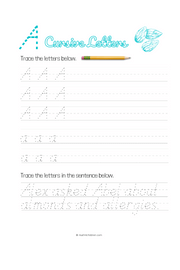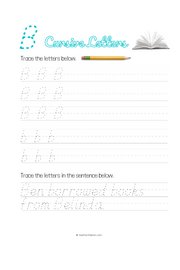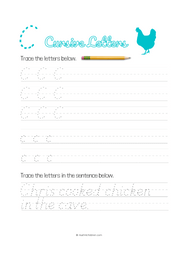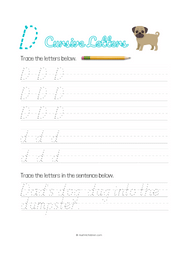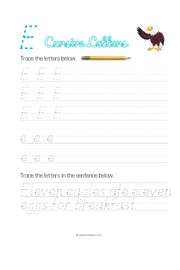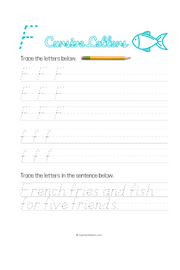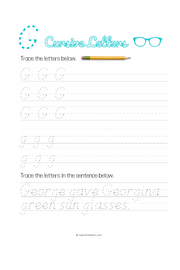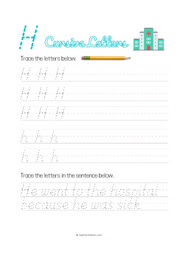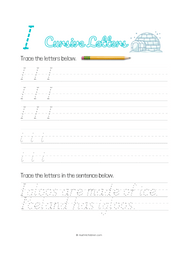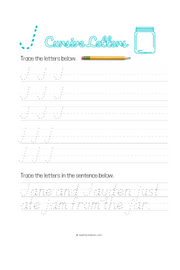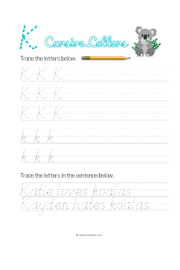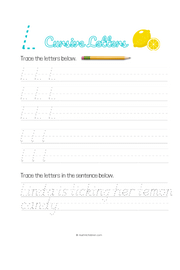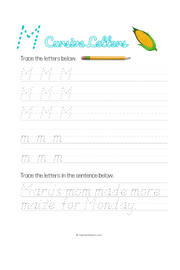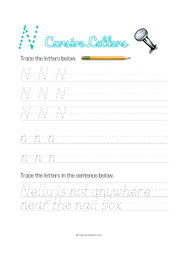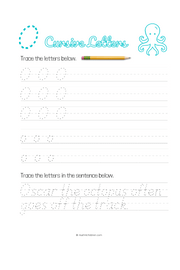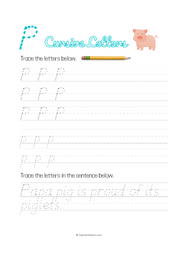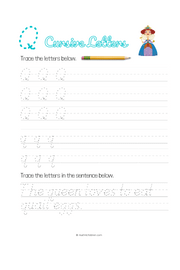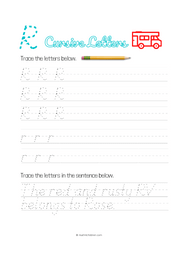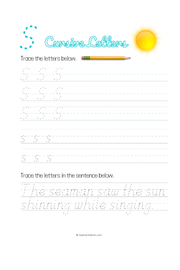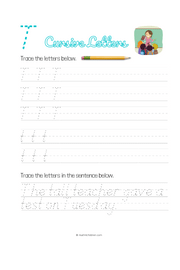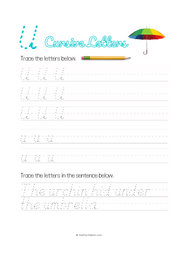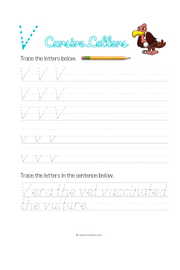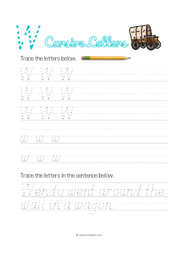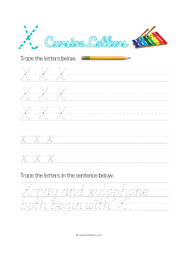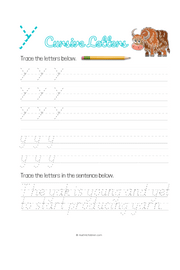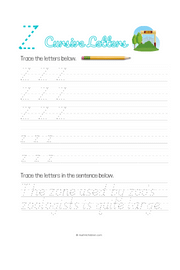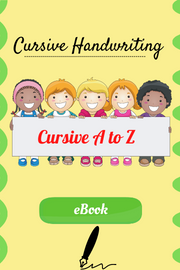Cursive Writing Practice Sheets | Cursive writing worksheets pdf
This page contains Cursive writing practice sheets which teachers and parents can use. These worksheets are all free pdf printable downloads. More information on the topic is found below this page.
Table of Contents
- Introduction to Cursive Writing
- The History of Cursive Writing
- The Importance of Cursive
- Writing in the Modern World
- Understanding the Basics of Cursive Writing
- The Cursive Alphabet: Uppercase Letters
- The Future of Cursive Writing
- Cursive Letters Chart
Introduction to Cursive Writing
Cursive writing is a style of penmanship in which the letters of a word are connected by flowing strokes. It is also known as script writing or longhand. The word "cursive" is derived from the Latin word "cursivus," which means "running." The primary goal of cursive writing is to make the writing process faster and more fluid, allowing the writer to create legible words with fewer breaks.
Cursive writing is taught in many schools as a part of the standard curriculum, typically in the third or fourth grade. It is an important skill to develop as it improves hand-eye coordination, fine motor skills, and cognitive skills. In addition, studies have shown that writing in cursive can increase memory retention and comprehension.
In cursive writing, each letter is written in a unique way, with its own set of strokes and loops. The letters flow together to form words, and the words flow together to form sentences. This fluidity allows the writer to write faster and more legibly than they would be able to with print writing.
Overall, learning cursive writing can be a fun and rewarding experience that helps to improve many skills. With practice, you can develop your own unique style of cursive writing that is both legible and expressive.
The History of Cursive Writing
Cursive writing is a form of handwriting in which the letters are connected, allowing for faster and more efficient writing. It has a long and rich history that dates back to the ancient civilizations of Greece and Rome.
In the early days of writing, cursive was used primarily for personal correspondence and diaries. The earliest known examples of cursive writing are found in Greek manuscripts from the 8th century BCE. The Romans also used a form of cursive writing known as "shorthand," which was used by scribes to take notes and write official documents.
During the Middle Ages, cursive writing became more standardized and was used for both personal and official documents. Monks in monasteries used cursive writing for copying religious texts, and the style of handwriting developed into what is now known as "Gothic" script.
In the Renaissance, a new form of cursive writing known as "italic" script was developed. This style, which was created by the Italian humanist Petrarch, was characterized by its fluid and flowing lines, and it quickly became popular for both personal and official writing.
In the 19th and 20th centuries, cursive writing became a standard part of formal education in many countries. Students were taught to write in cursive as part of their regular school curriculum, and it remained a widely used form of handwriting until the widespread adoption of computers and the internet in the late 20th and early 21st centuries.
Today, while cursive writing is still taught in some schools, its use has declined significantly with the increasing reliance on technology for communication and record-keeping. Nevertheless, it remains an important part of the history of writing and continues to be used by many people for personal writing and calligraphy.
The Importance of Cursive Writing in the Modern World
There are still several reasons why cursive writing remains relevant and valuable today.
-
Improved fine motor skills: Writing in cursive requires coordination between the hand, wrist, and fingers, which can improve fine motor skills and dexterity.
-
Brain development: Studies have shown that the act of writing in cursive can activate different parts of the brain than typing, leading to improved cognitive development and learning.
-
Improved handwriting: Cursive writing can improve overall handwriting and legibility, which can be especially useful for individuals who need to write by hand in their personal or professional lives.
-
Historic significance: Cursive writing is a part of history and cultural heritage, and learning it can provide a connection to the past and a greater appreciation for the evolution of written language.
-
Personal expression: Cursive writing is a unique form of personal expression and can be a form of artistic expression.
-
In conclusion, while technology has changed the way we communicate and write, cursive writing still holds value and relevance in the modern world. It can improve fine motor skills, brain development, handwriting, and serve as a connection to our cultural heritage and a form of personal expression.
Understanding the Basics of Cursive Writing
Cursive writing is a style of penmanship where the characters are connected by fluid, flowing lines. The word "cursive" comes from the Latin word "cursivus," which means "running." In this style of writing, each letter is written in a connected manner, making the writing process quicker and more fluid.
Here are some basic principles of cursive writing:
-
Slant: The letters in cursive writing are usually written with a slight slant to the right. This helps to make the writing look more aesthetically pleasing and easier to read.
-
Connections: One of the defining characteristics of cursive writing is the connections between letters. The pen should not be lifted from the paper between letters, except when starting a new word.
-
Flow: The letters in cursive writing should flow smoothly from one to the next, without any sharp angles or abrupt changes in direction.
-
Height: The height of the letters should be consistent throughout a word, with the ascenders (such as the tops of the letters "d" and "h") and descenders (such as the bottom of the letter "p") being slightly taller or shorter than the rest of the letters.
-
Pen pressure: Cursive writing should be done with a light touch, using just enough pressure to make a clear, legible mark. Too much pressure can make the writing look heavy and difficult to read.
-
Cursive writing is an important skill for children to learn as it helps to improve fine motor skills, handwriting speed and legibility, and cognitive development. With practice, it can also be a beautiful and expressive form of writing.
The Cursive Alphabet: Uppercase Letters
Here are the uppercase letters in cursive:
A - Start at the top, make a loop to the right and then down, connect to the starting point with a straight line.
B - Start at the top, make a loop to the right and then down, loop back up to the top and then down to the baseline.
C - Start at the top, curve down and to the left, loop back up to the top and then down to the baseline.
D - Start at the top, make a loop to the right and then down, loop back up to the top and then down to the baseline, connecting to the starting point with a straight line.
E - Start at the top, go straight down to the baseline, loop back up to the top, go straight down to the baseline again, then make a small loop at the bottom.
F - Start at the top, go straight down to the baseline, loop back up to the top, go straight down to the baseline again, then make a straight line at the bottom.
G - Start at the top, curve down and to the left, loop back up to the top, go down to the baseline, then make a loop to the right and connect to the starting point.
H - Start at the top, go straight down to the baseline, make a loop back up to the top, go straight down to the baseline again, and make a loop back up to the top.
I - Start at the top, go straight down to the baseline, and then make a loop back up to the top.
J - Start at the top, go straight down to the baseline, make a loop to the right at the bottom and connect to the baseline.
K - Start at the top, make a diagonal line to the right, loop back up to the top and then make a diagonal line down to the right.
L - Start at the top, go straight down to the baseline, and then make a straight line to the right at the bottom.
M - Start at the top, make two diagonal lines to the right, connecting them at the bottom.
N - Start at the top, make a diagonal line to the right, go straight down to the baseline and then make a diagonal line to the left.
O - Start at the top, curve down and to the left, loop back up to the top, curve down and to the right, and connect to the starting point.
P - Start at the top, make a loop to the right and then down, loop back up to the top and then make a straight line to the right at the bottom.
Q - Start at the top, curve down and to the left, loop back up to the top, curve down and to the right, connect to the starting point, and then make a loop at the bottom right.
R - Start at the top, make a loop to the right and then down, loop back up to the top, make a straight line to the right, and then make a diagonal line down to the right.
S - Start at the top, curve down and to the right, loop back up to the top, curve down and to the left, and connect to the starting point.
T - Start at the top, go straight down to the baseline, make a straight line to the right at the top, and then make a straight line to the left at the bottom.
U - Start at the top, go straight down to the baseline, make a loop back up to the top, and then go straight down to the baseline again.
The Future of Cursive Writing
The future of cursive writing is a topic of much debate, as technology has changed the way people communicate and write. In today's digital age, many people rely on typing and keyboarding skills instead of handwriting, which has led to a decrease in the emphasis on teaching cursive writing in schools.
However, some experts argue that there are benefits to learning and practicing cursive writing, including improved fine motor skills, enhanced cognitive development, and a deeper connection to the written word. Additionally, cursive writing has a rich history and cultural significance, and some people feel that it is an important part of preserving tradition.
As a result, some schools are continuing to teach cursive writing, either as a separate subject or integrated into language arts classes. Others are dropping it from the curriculum altogether.
It's difficult to predict the exact future of cursive writing, as it may continue to be taught in some form in some schools, while others may phase it out completely. However, it's important to note that even if cursive writing is not taught in schools, people will still have the option to learn and practice it on their own if they choose to do so.
Cursive writing FAQ
-
What is cursive writing? Cursive writing is a style of handwriting where the letters are connected with each other to form words. This style of writing was once widely used in schools to teach students how to write legibly and quickly.
-
Why is cursive writing taught in schools? Cursive writing is taught in schools for a number of reasons. One reason is that it helps improve a student's fine motor skills and hand-eye coordination. Additionally, cursive writing can also help students develop their writing speed and improve their overall penmanship.
-
Is cursive writing still taught in schools? The teaching of cursive writing has become less common in recent years, with some schools opting to focus on typing and keyboarding skills instead. However, many schools still teach cursive writing as part of their language arts curriculum.
-
How do I teach my child to write in cursive? To teach your child to write in cursive, start with the basics such as letter formation and practice writing individual letters. Then, move on to practicing words and sentences. Provide plenty of opportunities for your child to practice writing in cursive and offer positive reinforcement and encouragement along the way.
-
What are the benefits of learning cursive writing? Some benefits of learning cursive writing include improved handwriting, increased writing speed, and improved fine motor skills. Additionally, some studies have shown that writing in cursive can also improve cognitive development and help with memory retention.
-
Is it necessary to know how to write in cursive in today's world? While it is not strictly necessary to know how to write in cursive in today's world, it can still be a valuable skill to have. Cursive writing is still used in some professional settings, such as in signature on legal documents, and it can also be a creative outlet for personal expression.

